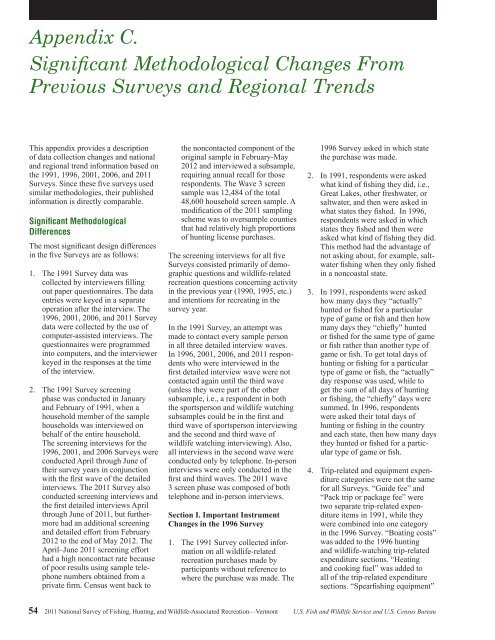2011 National Survey of Fishing, Hunting, and ... - Census Bureau
2011 National Survey of Fishing, Hunting, and ... - Census Bureau
2011 National Survey of Fishing, Hunting, and ... - Census Bureau
Create successful ePaper yourself
Turn your PDF publications into a flip-book with our unique Google optimized e-Paper software.
Appendix C.<br />
Significant Methodological Changes From<br />
Previous <strong>Survey</strong>s <strong>and</strong> Regional Trends<br />
This appendix provides a description<br />
<strong>of</strong> data collection changes <strong>and</strong> national<br />
<strong>and</strong> regional trend information based on<br />
the 1991, 1996, 2001, 2006, <strong>and</strong> <strong>2011</strong><br />
<strong>Survey</strong>s. Since these five surveys used<br />
similar methodologies, their published<br />
information is directly comparable.<br />
Significant Methodological<br />
Differences<br />
The most significant design differences<br />
in the five <strong>Survey</strong>s are as follows:<br />
1. The 1991 <strong>Survey</strong> data was<br />
collected by interviewers filling<br />
out paper questionnaires. The data<br />
entries were keyed in a separate<br />
operation after the interview. The<br />
1996, 2001, 2006, <strong>and</strong> <strong>2011</strong> <strong>Survey</strong><br />
data were collected by the use <strong>of</strong><br />
computer-assisted interviews. The<br />
questionnaires were programmed<br />
into computers, <strong>and</strong> the interviewer<br />
keyed in the responses at the time<br />
<strong>of</strong> the interview.<br />
2. The 1991 <strong>Survey</strong> screening<br />
phase was conducted in January<br />
<strong>and</strong> February <strong>of</strong> 1991, when a<br />
household member <strong>of</strong> the sample<br />
households was interviewed on<br />
behalf <strong>of</strong> the entire household.<br />
The screening interviews for the<br />
1996, 2001, <strong>and</strong> 2006 <strong>Survey</strong>s were<br />
conducted April through June <strong>of</strong><br />
their survey years in conjunction<br />
with the first wave <strong>of</strong> the detailed<br />
interviews. The <strong>2011</strong> <strong>Survey</strong> also<br />
conducted screening interviews <strong>and</strong><br />
the first detailed interviews April<br />
through June <strong>of</strong> <strong>2011</strong>, but furthermore<br />
had an additional screening<br />
<strong>and</strong> detailed effort from February<br />
2012 to the end <strong>of</strong> May 2012. The<br />
April–June <strong>2011</strong> screening effort<br />
had a high noncontact rate because<br />
<strong>of</strong> poor results using sample telephone<br />
numbers obtained from a<br />
private firm. <strong>Census</strong> went back to<br />
the noncontacted component <strong>of</strong> the<br />
original sample in February-May<br />
2012 <strong>and</strong> interviewed a subsample,<br />
requiring annual recall for those<br />
respondents. The Wave 3 screen<br />
sample was 12,484 <strong>of</strong> the total<br />
48,600 household screen sample. A<br />
modification <strong>of</strong> the <strong>2011</strong> sampling<br />
scheme was to oversample counties<br />
that had relatively high proportions<br />
<strong>of</strong> hunting license purchases.<br />
The screening interviews for all five<br />
<strong>Survey</strong>s consisted primarily <strong>of</strong> demographic<br />
questions <strong>and</strong> wildlife-related<br />
recreation questions concerning activity<br />
in the previous year (1990, 1995, etc.)<br />
<strong>and</strong> intentions for recreating in the<br />
survey year.<br />
In the 1991 <strong>Survey</strong>, an attempt was<br />
made to contact every sample person<br />
in all three detailed interview waves.<br />
In 1996, 2001, 2006, <strong>and</strong> <strong>2011</strong> respondents<br />
who were interviewed in the<br />
first detailed interview wave were not<br />
contacted again until the third wave<br />
(unless they were part <strong>of</strong> the other<br />
subsample, i.e., a respondent in both<br />
the sportsperson <strong>and</strong> wildlife watching<br />
subsamples could be in the first <strong>and</strong><br />
third wave <strong>of</strong> sportsperson interviewing<br />
<strong>and</strong> the second <strong>and</strong> third wave <strong>of</strong><br />
wildlife watching interviewing). Also,<br />
all interviews in the second wave were<br />
conducted only by telephone. In-person<br />
interviews were only conducted in the<br />
first <strong>and</strong> third waves. The <strong>2011</strong> wave<br />
3 screen phase was composed <strong>of</strong> both<br />
telephone <strong>and</strong> in-person interviews.<br />
Section I. Important Instrument<br />
Changes in the 1996 <strong>Survey</strong><br />
1. The 1991 <strong>Survey</strong> collected information<br />
on all wildlife-related<br />
recreation purchases made by<br />
participants without reference to<br />
where the purchase was made. The<br />
1996 <strong>Survey</strong> asked in which state<br />
the purchase was made.<br />
2. In 1991, respondents were asked<br />
what kind <strong>of</strong> fishing they did, i.e.,<br />
Great Lakes, other freshwater, or<br />
saltwater, <strong>and</strong> then were asked in<br />
what states they fished. In 1996,<br />
respondents were asked in which<br />
states they fished <strong>and</strong> then were<br />
asked what kind <strong>of</strong> fishing they did.<br />
This method had the advantage <strong>of</strong><br />
not asking about, for example, saltwater<br />
fishing when they only fished<br />
in a noncoastal state.<br />
3. In 1991, respondents were asked<br />
how many days they “actually”<br />
hunted or fished for a particular<br />
type <strong>of</strong> game or fish <strong>and</strong> then how<br />
many days they “chiefly” hunted<br />
or fished for the same type <strong>of</strong> game<br />
or fish rather than another type <strong>of</strong><br />
game or fish. To get total days <strong>of</strong><br />
hunting or fishing for a particular<br />
type <strong>of</strong> game or fish, the “actually”<br />
day response was used, while to<br />
get the sum <strong>of</strong> all days <strong>of</strong> hunting<br />
or fishing, the “chiefly” days were<br />
summed. In 1996, respondents<br />
were asked their total days <strong>of</strong><br />
hunting or fishing in the country<br />
<strong>and</strong> each state, then how many days<br />
they hunted or fished for a particular<br />
type <strong>of</strong> game or fish.<br />
4. Trip-related <strong>and</strong> equipment expenditure<br />
categories were not the same<br />
for all <strong>Survey</strong>s. “Guide fee” <strong>and</strong><br />
“Pack trip or package fee” were<br />
two separate trip-related expenditure<br />
items in 1991, while they<br />
were combined into one category<br />
in the 1996 <strong>Survey</strong>. “Boating costs”<br />
was added to the 1996 hunting<br />
<strong>and</strong> wildlife-watching trip-related<br />
expenditure sections. “Heating<br />
<strong>and</strong> cooking fuel” was added to<br />
all <strong>of</strong> the trip-related expenditure<br />
sections. “Spearfishing equipment”<br />
54 <strong>2011</strong> <strong>National</strong> <strong>Survey</strong> <strong>of</strong> <strong>Fishing</strong>, <strong>Hunting</strong>, <strong>and</strong> Wildlife-Associated Recreation—Vermont U.S. Fish <strong>and</strong> Wildlife Service <strong>and</strong> U.S. <strong>Census</strong> <strong>Bureau</strong>
















